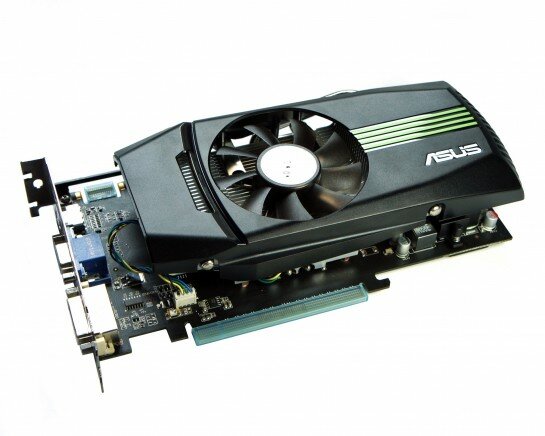TOP’d up and ready to rock!
Typically it’s not the $500 performance breaking monsters that are the most attractive to buy, it’s the $100-$150 segment that offers the best cost-performance ratio for upgraders. This is where Nvidia’s latest DirectX 11 graphics card, the GeForce GTS 450 drops in.
Although, ASUS evidently wasn’t content card as Nvidia provided, so TOP’d it off with a combination of its own engineering and a supreme overclock to give us the maximum gaming experience, right out the box.
This also helps differentiate it in a market full of GeForce GTS 450′s. We want something something that stands out from the crowd – something worth our notes: added value from quality, overclocking and quietness. This as its ENGTS450 and ENGTS450 TOP has all of them in spades.
For starters, lets check the specs of the new Nvidia GeForce GTS 450:
- 1GB of the latest GDDR5 memory at 900MHz (3.6GHz effective) on a 128-bit bus – roughly equivalent to that of ATI’s mainstream Radeon HD 5770 and 5750 hardware. While also super fast, GDDR5 memory chips are specifically designed for graphics cards and even at these speeds generally run quite cool too.
- 192 CUDA cores; an upgrade from the previous GTS 250 that only had 128. These cores on the GTS 450 have a stock frequency of 783MHz, and a shader clock of 925MHz for the intensive graphical work. Even with fewer cores than the older GTX260-216, the hefty clock speed advantage actually makes the new GTS 450 a winner overall.
- DVI and HDMI outputs have HDCP compliance as standard, and there’s also standard d-sub for older CRT monitors and some HDTVs.
The basic package is a core upgrade from Nvidia’s previous mainstream graphics card, like the incredibly popular GeForce GTS 250 and even GTX 260 in some respects. The GeForce GTS 450 is smaller, cooler running and has the latest DirectX 11 tech like Tesselation, and Nvidia’s tech like PhysX and CUDA built in. Outside of this, ASUS has still gone the extra mile on its own terms though; in essence, the ENGTS450 is certainly not a stock card with a new sticker: it’s re-engineered from the ground up.
The ENGTS450 TOP might have the same compact 8.5 inch PCB size but it’s now a sexy matt black colour with a unique PCB stiffener to prevent the wear of upgrading.
On that PCB, ASUS has also beefed the power hardware from three phases to four and has replaced standard components for very high capacity and high quality ‘POSCAP’s, solid capacitors and sealed chokes to properly reinforce support for its renowned Voltage Tweak software. Combined together all these hardware elements and the software to control it yields an essential marriage not just to maximise an overclock, but to provide a stable, reliable overclock for everyday gaming – this is something many competitive products lack.
Not content with just throwing on any old after-market cooler on top of its customised PCB, ASUS has also worked to create its own cooler because doing both means the whole product is designed and tested to work in every situation.
Heatpipes are often used as an effective method to duct heat away from a graphics core, and in this case ASUS’ card this is no different – however ASUS has moved the heatpipes right in contact with the core to maximise the heat transmission. Using two, 100% copper in the pipes (hence the Direct-CU brand-name) with a nickel plating to prevent tarnishing, not only means that the heat is transferred as efficiently as possible but also highlights the long term reliability demanded by ASUS. Having poo-brown instead of vibrant orange heatpipes in six months certainly doesn’t look good.
In contrast then, ASUS’ choice for a single, small fan on its heatsink might appear painfully noisy, but in fact the opposite is true – the Direct-CU heatpipes are so effective that ASUS had to opt for a 4-pin PWM fan so it can regulate its low speed with much greater precision. As such, it now operates a full 10dB quieter than the Nvidia stock GTS 450 fan. Considering every 3dB is a doubling in noise, that’s over eight fold quieter: an undoubtedly noticeable difference.
Now, lets take it to the TOP
ASUS TOP series has brings all this together and specially picks the super-overclocking cards for real performance enthusiasts. This is what the TOP series has always stood for actually, and the ENGTS450 TOP is no different.
 The best-of-the-best hardware is picked and performance tuned to the limit; as such the core is now overclocked to an incredible 925MHz with the shader clock sits at a whopping 1.3GHz! Those are massive increments of 18 and 40.5 per cent respectively. Not only that but the memory has been upgraded from 900MHz to 1GHz (3.6GHz to 4GHz effective), adding another significant bump to memory bandwidth in order to balance the system.
The best-of-the-best hardware is picked and performance tuned to the limit; as such the core is now overclocked to an incredible 925MHz with the shader clock sits at a whopping 1.3GHz! Those are massive increments of 18 and 40.5 per cent respectively. Not only that but the memory has been upgraded from 900MHz to 1GHz (3.6GHz to 4GHz effective), adding another significant bump to memory bandwidth in order to balance the system.
Because the core is specially selected by ASUS, if you want to add a bit more voltage and try for the full 1GHz/1.5GHz you’re also more likely to achieve it than buying a stock card. That’s not to say stock cards won’t ever achieve this, but out of the hundreds of thousands of GTS 450s shipped – if you enjoy tweaking to achieve the heaviest of overclocks, then it’s worth stacking the odds in your favour.









